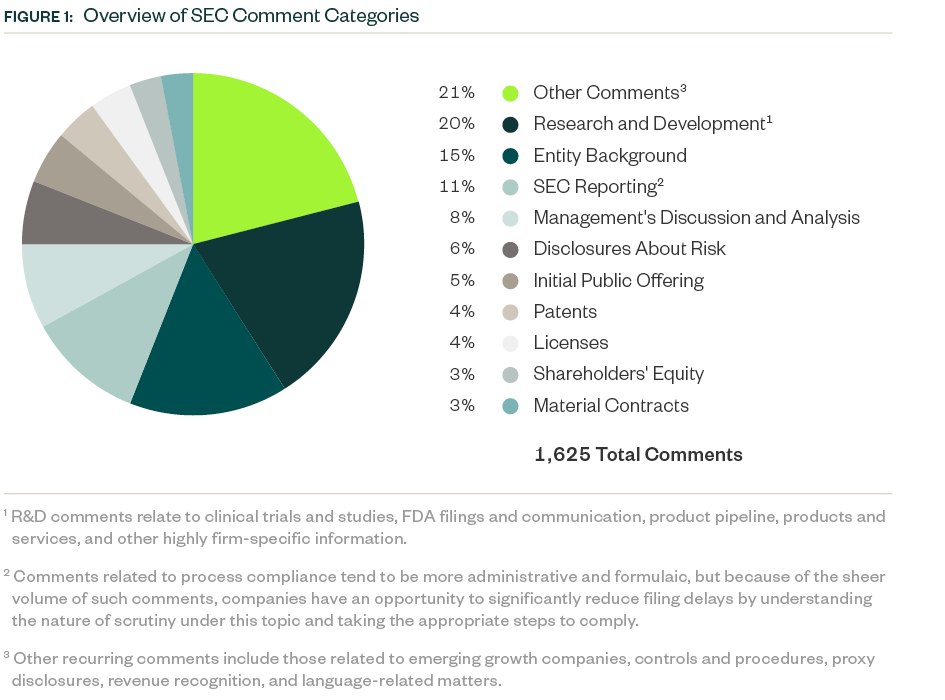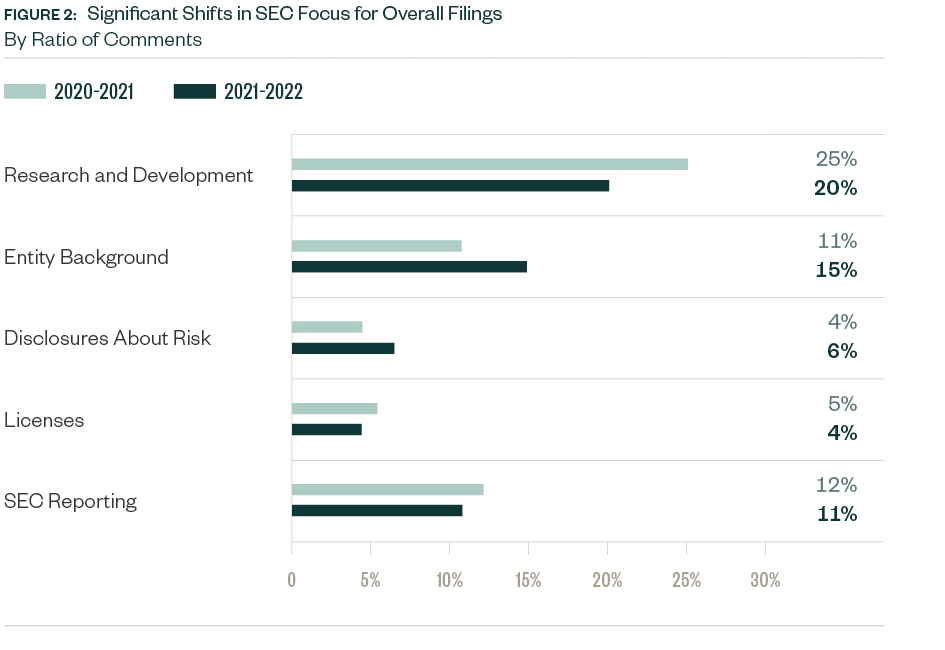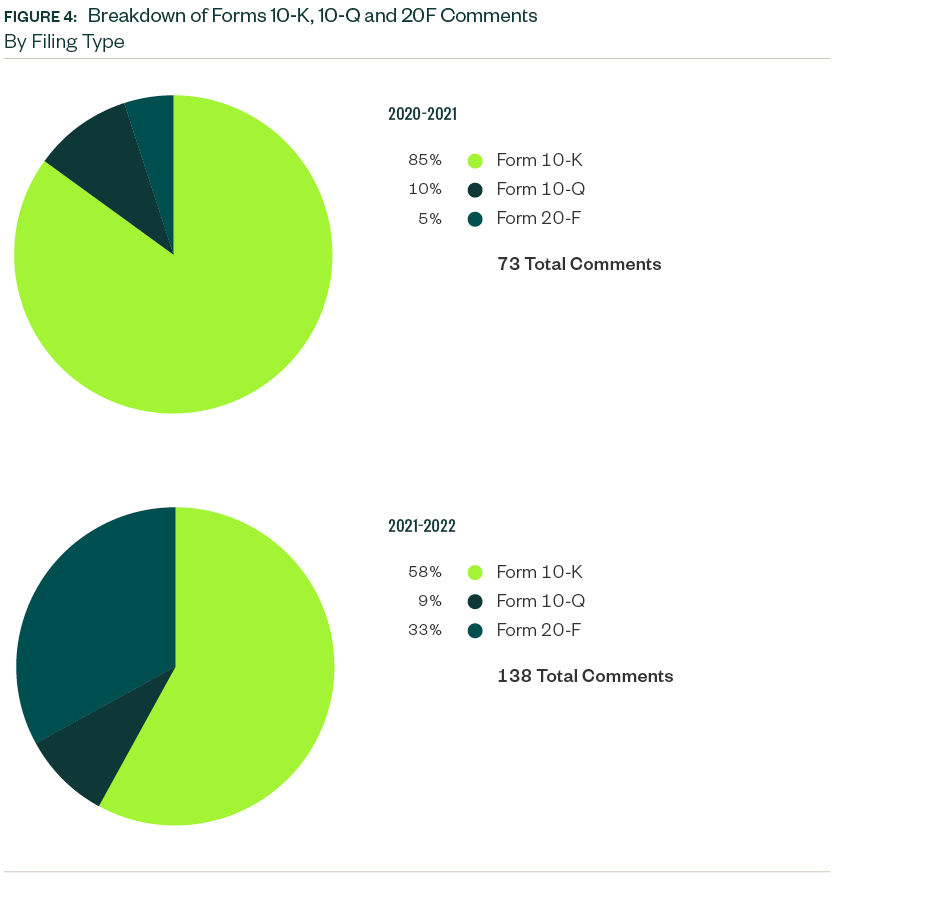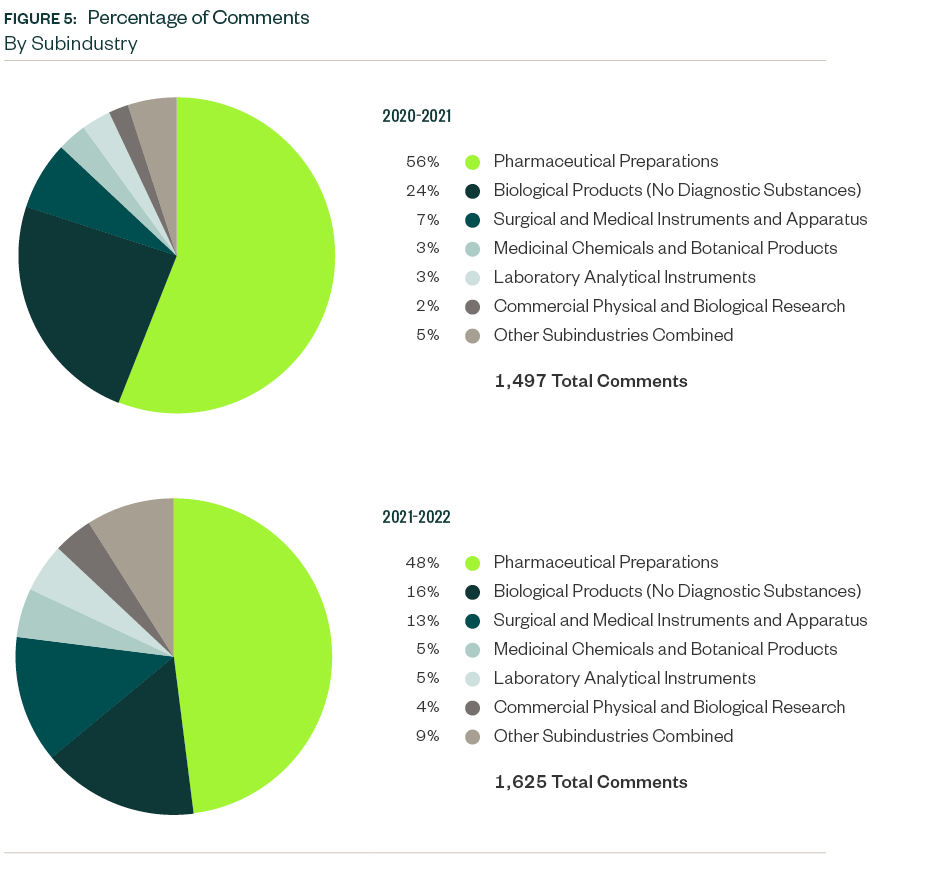
With pandemic fears easing, holistic health care solutions are growing in popularity. The life sciences space is replete with innovation and the race to find breakthrough therapies for chronic and unmet diseases is in full swing.
Going public is a core strategy that opens financing avenues and investor support for large and small companies. Many life sciences companies continue to view initial public offerings (IPOs) as a key liquidity event as they forge ahead with R&D activities and broaden product portfolios.
For those initiating a first registration statement or making continuous public filings every year, adherence to SEC standards is key.
Understanding past SEC scrutiny encourages proactive preparedness, helping companies avoid similar comments and potentially saving time and money.
Our report, Under the Microscope: An Analysis of SEC Comment Letter Trends Among Middle-Market and Pre-IPO Life Sciences Companies, looks at SEC comments directed towards Forms S-1, 10-K, 10-Q, and 20-F filings made by life sciences companies during a review period from May 1, 2021, to April 30, 2022. Comments were analyzed by frequency to identify the most prominent topics under SEC scrutiny.
Below, we cover key findings in the 2021–2022 SEC report, comparisons to findings from prior years, and implications for middle-market and pre-IPO life sciences companies.
Initial Findings
As in previous years, R&D continued as the largest area of SEC focus in 2021–2022, with a strong emphasis on disclosures surrounding companies’ clinical trials and in-product development.
Focus on entity-related disclosures grew, with the SEC asking many companies to thoroughly explain their existing business models, especially in the context of their underlying structure and management.
Comment Categories
The SEC had 1,625 comments for the Forms S-1, 10-K, 10-Q, and 20-F filings during 2021–2022.
Some key categories comprised the bulk of the comments, and those related to R&D represented a 20.1% share. As in previous years, the SEC focused on ensuring complete disclosure of clinical trials and studies, requiring clarity and objectivity in developmental products and pipelines.
Comments about entity background was a major category this period, at a 14.6% share. The SEC focused on requiring registrants to thoroughly describe business operations in the beginning of the prospectus, which included detailing the current offering mix, market dynamics, and regulatory scope.
SEC reporting, or process compliance, was the next most prominent comment category with a share of 10.8%. This category, as in the 2020–2021 period had the most comments requiring companies to make requisite and consistent disclosures throughout their prospectus, including filing all material information.
This was followed by comments requiring disclosure of the following:
- Management’s discussion and analysis (MD&A)
- Current and anticipated risks related to the business
- Details on the actual offering and use of proceeds
Information around underlying patents, licensing agreements, shareholders’ equity, and material contracts collectively constituted another significant portion of SEC scrutiny, followed by various comments targeting firm-specific controls and regulatory features.
The following infographic depicts a breakdown of the total 1,625 comments analyzed, according to category and frequency.

Significant Shifts
Numerous topics saw shifts in focus ranging from slight to significant compared to 2020–2021, with the positive or negative variance measured as a ratio to the total number of comments.
This included categories such as:
- R&D
- Entity background
- Risk-based disclosures
- Licensing agreements
- Process compliance

Comments related to entity background and risk-based disclosures increased in focus by 3.1% and 2.1% respectively. Comments directed towards R&D decreased by 4.9%, while those related to licensing agreements and process compliance slightly decreased by 1.8% and 1.4% respectively.
The mean variance of overall comments slightly decreased from 1.8% in 2020–2021 to 1.3% this period, related to the moderate shift in total number of comments and categorization spread.
Filing Type
Similar to prior years, Form S-1 filings continued to lead in relation to SEC scrutiny. Of the 1,625 total comments analyzed in the study, roughly 92%—or 1,487 comments—were directed at Form S-1 filings. This is a slight decrease from a share of 95% in 2020–2021.
The remaining 8% of comments were directed towards Forms 10-K, 10-Q, and 20-F filings.

Similar to the 2020–2021 study, the nature of comment categorization varied among pre- and post-IPO companies. Comments related to R&D, entity background, process compliance, and the actual offering remained dominant for Form S-1s, while those related to risk-based disclosures came into greater focus this period.
The SEC required pre-IPO candidates to be comprehensive in making disclosures about business operations, asking for transparency for investors about organizational structure and background.
The scrutiny was different for periodic financial statements reporting. MD&A remained the focus, like last period, with the SEC requiring many companies to be clear and consistent with disclosure of operational results year-over-year. They were asked to, among other things, provide requisite calculations for certain financial metrics, outline the accounting guidance used throughout their financial statements, and explain the implication of macro volatility on results.
Market Capitalization Range

Over 73% of Forms 10-K, 10-Q, and 20-F comments were centered on companies with a market capitalization of less than $500 million. Of the remainder, 10% were directed towards those with market capitalization between $500 million and $1 billion while 17% pertained to those greater than $1 billion but less than $2 billion.
Smaller companies continued to attract the greatest scrutiny.
Results by Subindustry

The SEC focused on the pharmaceutical preparations subindustry more than most analyzed in this study. Total SEC comments on that subindustry decreased from a 55.8% share in 2020–2021 to 47.9% this period, but its significance in relation to all other subindustries was static.
Biological products stood as the next most significant subindustry with an aggregate comment share of 15.9%, followed by surgical and medical instruments and apparatus at 13.2%.
While the ratio of comments for surgical and medical instruments and apparatus went up by 5.9% from the previous study, biological products comments dropped 7.8%. The increase and decrease pattern between these subindustries persisted for three consecutive twelve-month periods.
Medical chemicals and botanical products was the fourth largest subindustry with a comment share of 5.2%. SEC focus here considerably went up from the previous report.
A mix of various other subindustries followed with shares of less than 5% each.
Ophthalmic goods and dental equipment and supplies, which didn’t attract any relevant comments in 2020–2021, accounted for 44 and 18 comments this period, respectively.
Additional Content
The SEC considers both the macro environment and business-specific value chains when directing the nature of review. While topics like process compliance were generically commonplace for the entire life sciences sector, others varied among subindustries.
For example, scrutiny over R&D remained more significant for pharmaceutical preparations and biological products, while entity-related disclosures were a focus for laboratory analytical instruments.
This doesn’t mean, however, that the nature of comments within a subindustry remains static. Certain topics may attract greater scrutiny in certain years. This depends on market dynamics at the time of the SEC’s analysis, which may bring certain issues to the forefront, and the efforts companies undertake to properly address those areas in their statements.
We’re Here to Help
For more information on SEC comments read our full guide or contact your Moss Adams professional.